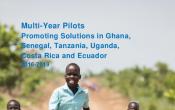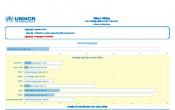Ghana
Operation: Ghana
Location
{"longitude":-1,"latitude":8,"zoom_level":7}
Latest update of camps and office locations 21 Nov 2016. By clicking on the icons on the map, additional information is displayed.
Key Figures
| 2016 end-year results | |
| 95% | of refugees in camps were registered in the National Health Insurance Scheme (NHIS) |
| 97 | refugees departed on resettlement from Ghana to third countries |
| 60 | refugees were assisted in their return to home countries (52 returned to Cote d’Ivoire) |
| 2017 planning figures | |
| 1,300 | Togolese refugees will be supported for accessing alternative legal status, either through naturalization or the acquisition of an indefinite residence status, and with a cash grant for local integration |
| 750 | Ivorian refugees will be provided with safe transport under the voluntary return programme |
| 2,000 | Ivorian refugees will receive cash or vouchers for livelihood |
| 450 | additional Ivorian refugees will receive cash or vouchers for agriculture/livestock purposes to support livelihoods |
| 1,040 | additional Ivorian refugees will be provided with guidance on business market opportunities for self-reliance |
Latest Updates
People of Concern
31%
Decrease in
2016
2016
| 2016 | 13,236 |
| 2015 | 19,265 |
| 2014 | 21,088 |

[["Refugees",11865],["Asylum-seekers",1371]]
Loading ...
Ghana
< Back
2016
{"categories":[2012,2013,2014,2015,2016,2017],"budget":[12.23259258,12.09932992,11.01536939,10.948861362,9.44475501,8.87886663],"expenditure":[6.16427869,6.82506467,6.26076977,5.30940838,5.07294779,null]}
{"categories":[2012,2013,2014,2015,2016,2017],"p1":[10.94353769,11.76940415,10.78536939,10.948861362,9.44475501,8.87886663],"p2":[null,null,null,null,null,null],"p3":[1.28905489,0.32992577,0.23,null,null,null],"p4":[null,null,null,null,null,null]}
{"categories":[2012,2013,2014,2015,2016,2017],"p1":[5.60727547,6.76650996,6.26076977,5.30940838,5.07294779,null],"p2":[null,null,null,null,null,null],"p3":[0.55700322,0.05855471,null,null,null,null],"p4":[null,null,null,null,null,null]}
Loading ...
CHOOSE A YEAR
- 2015
- 2016
- 2017
Year-end Overview
Working environment
In 2016, Ghana continued to enjoy political and democratic stability and experienced a smooth handover of power to the new President Akufo-Addo.Ghana offers a relatively generous asylum approach for refugees, based on a wider interpretation of Article 1A of the 1951 Convention Relating to the Status of Refugees and Article 1 of the 1969 Organization of African Unity (OAU) Convention Governing the Specific Aspects of Refugee Problems in Africa.
A number of UNHCR’s key priorities faced delays as a result of the December 2016 election and subsequent change of government. These included the operationalization of the Multi-Year Multi-Partner (MYMP) Strategy on legal modalities of local integration of Togolese refugees and other protracted refugee groups, comprehensive revision of the 1992 Refugee law, and accession to the statelessness conventions.
Population trends
As a result of the Multipurpose Enhanced Registration Exercise (MERE) conducted in Accra and in all four camps, at the end of 2016, Ghana hosted just under 11,900 refugees and 1,400 asylum-seekers totaling some 13,300 people of concern. These included some 7,000 Ivorians, 3,400 Togolese, 1,400 Liberians and 1,500 other nationals.Achievements and impact
- An important step toward increasing the identification of statelessness was achieved with the signing of a Memorandum of Understanding between UNHCR and the Commission on Human Rights and Administrative Justice (CHRAJ).
- UNHCR worked with Ghana Refugee Board (GRB) to finalize the standard operating procedures for implementation of minimal asylum procedural safeguards.
- Refugees are now included in the National Social Protection Policy and are eligible for social protection programmes.
- UNHCR handed over two upgraded and fully equipped National Health Insurance Authority (NHIS) accredited health facilities to the Ghana Health Service (Ministry of Health) and the Catholic Health Service in line with mainstreaming of refugees services into the national health system.
- The administrative integration of schools in refugee camps into the national education system was completed.
Unmet needs
- 60 per cent of the camp population continue to live in tents more than 5 years after the refugee influx from Cote d’Ivoire to Ghana.
- Mainstreaming of social services (health and education) was expensive due to the high construction cost.
- In many cases, lack of timely additional funding resulted in delays in implementation. Additionally, costs increased due to inflation.
Plan Overview


